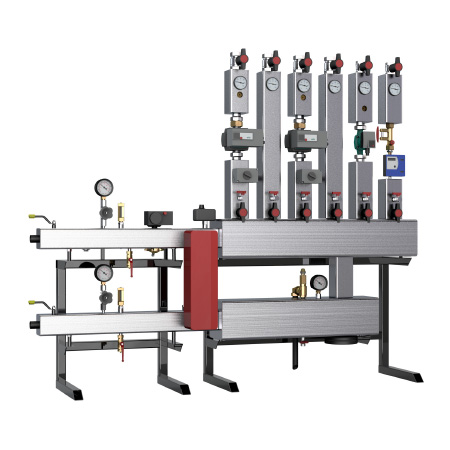All you need to know about Sailer transfer stations
District heating in urban and rural areas
District heating is a popular, environmentally friendly energy source as it does not produce any CO2or other emissions where it is used.
Heat provided directly to the building
Sailer local or district heat transfer stations can be connected directly to the heating circuits, or to a buffer tank that supplies all of the consumers, including the fresh water station.
Space-saving, compact devices
Sailer transfer stations are high-quality, made-to-measure devices which are extremely compact, robust and durable. The stations are designed with CAD, allowing the exact dimensions to be incorporated in the overall heating system plan.
Designed to meet the requirement of the network operators
The units are designed to take the current operating conditions and requirements of the network operators / suppliers into account right in the planning phase. The guidelines of the AGFW (German Heat & Power Association) and the DIN standard are also considered.
Design versions
Be it the supply to the weather-compensating heating circuits or domestic water systems – we are able to manufacture all components according to your requirements.
Our services from the design stage through to final commissioning
From accurate, property-specific CAD planning (system and system size as well as hydraulics), through individual production in accordance with the network operator's technical connection requirements, to assembly, connection and commissioning, your project is in good hands.
The product range is rounded off with Sailer system components.
Sailer supplies all system components compatible with the transfer stations such as stratified storage tanks with the Sailer stratification, fresh water stations, domestic stations / domestic control centres, solar collectors, and – to control the entire system – the MASTER system controller which can also be controlled externally via a remote portal on a PC and mobile devices.
Advantages for the designer
- Comprehensive total solution, all from one source
- Cost effective for new installations, renovations and refurbishments
- Customised design based on AGFW (German Heat & Power Association) and DIN 4747, as well as the TAB (technical connection requirements) for network operators
- CAD drawing for system planning and hydraulics
- Thermal insulation in accordance with ENEV
- Control of the complete system (remote maintenance, centralised alarm notifications)
- Identification of faults before the end customer via the remote portal
- Data logging via SD card
- Profitable total operating costs
- Comprehensive service including commissioning
Advantages for the installer
- Simple construction, project documentation and design
- Meets the requirements for a customised solution
- Easy to handle, install and commission
- Optimum system output and energy efficiency
- Comprehensive service including commissioning
Advantages for the system operator
- Efficient operation with low operational and return temperatures reduces the amount of energy lost and the operating costs
- Operation and consumption can be monitored and controlled via the Internet (remote maintenance, alarm notifications)
- Identification of faults via remote portal
- Data logging via SD card
- Minimal maintenance and repair costs
- Profitable total operating costs

![[Translate to Englisch:] NAWASTA](/fileadmin/dateien/bilder_speicher/bild_nawasta.jpg)